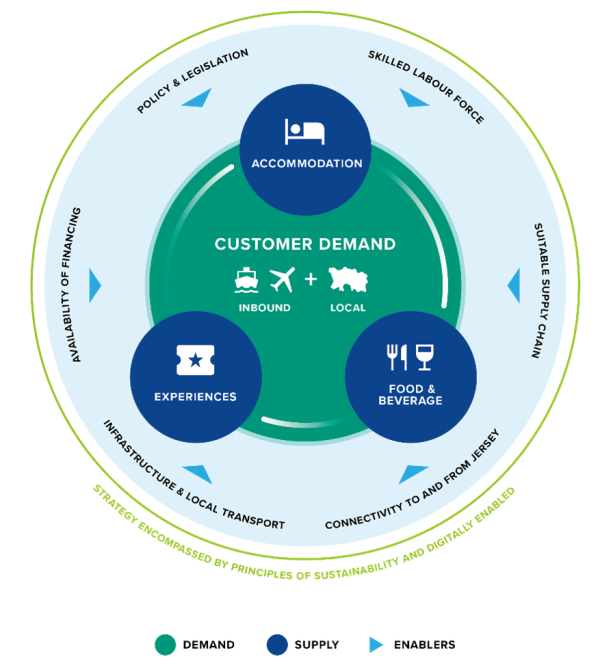Why are we talking about the Visitor Economy and not just Tourism?
We use the term Visitor Economy because this is a broader term concerned with the whole ecosystem and is more place-centric than the term Tourism, which is concerned with the person doing the visiting.
For those who want a definition, let me humour you:
According to the UNWTO “Tourism is a social, cultural and economic phenomenon which entails the movement of people to countries or places outside their usual environment for personal or business/professional purposes. These people are called visitors (which may be either tourists or excursionists; residents or non-residents) and tourism has to do with their activities, some of which involve tourism expenditure”
The Visitor Economy is “a place-centred concept concerned with the whole environment in which visitors, locals and tourists interact. It focuses on the elements that attract visitors and the infrastructure and services that support their visit.[1]”
And herein lies the key: The Visitor Economy is so much more than just tourism. It considers the whole supply chain and the businesses it comprises. It considers the interaction with the local community and the impact on it. Tourism cannot function without the other parts of the visitor economy and at its best it is a symbiotic relationship. For those who like a visual to explain things, we’ve got it covered:

In order to function, the Visitor Economy needs a number of moving parts to be present and to work in conjunction with each-other:
- Consumer demand – The source of revenue, or ‘Spend’ which filters through the economy. This includes inbound and local visitors, leisure, corporate and VFR[2]. The amount of each will depend on the type of destination or business and the time of day, week or year.
- The offering (supply) – The businesses that provide the product, service or experience to the consumer.
- Enablers – Conditions that must be present in order for the industry to function. These areas are likely to need the input of several stakeholders and government departments to create the right conditions
1 and 2 are increasingly needing to become digitally enabled, to engage with and provide the consumer experience, to support business operations and to provide data to decision makers in areas 2 and 3.
The whole system needs to work within the principles of sustainability (social, economic, environmental) for all stakeholders (businesses, guests, islanders etc).
This move towards a more inclusive definition and wider approach is not just a choice for Jersey. And it matters not just to policy makers and academics concerned with the topic. It matters for consumers, who are increasingly looking for a sense of place when they travel, and this highlights the importance of destinations being able to offer authenticity, and to enable visitors to experience things “’like a local’.
It also takes into account the local community, and the impact on it. Luckily we do not suffer from the levels of over-tourism seen in other destinations, but this doesn’t mean we can disregard how tourism can be shaped to have a positive impact on the life of Islanders, nor how it can help us to achieve some of our objectives as an Island and contribute positively to our quality and way of life.
For those who enjoy a bit of disruptive talk, a shift in the strategic lens is also a way of introducing new thinking into the way destinations develop themselves, by changing the narrative. In short, the question “What can the destination do for visitors?” becomes “What can visitors do for the destination?” Enter stage-left notions such as low-impact tourism, sustainable tourism and regenerative tourism. The benefit to the community becomes just as important as the revenue or tax take generated by visitor spend.
So what about the visitors, or in other words the customer mix? The ones with the money. The guests, the revenue source, the spenders. That which the whole visitor ecosystem relies upon to fund itself. We should bear in mind that all tourists are visitors, but that not all visitors are tourists. This is important, especially as an island where in-bound flows are at the mercy of more external forces than demand from Islanders themselves, and at times of year when visitor numbers are naturally lower.
There is an argument that businesses that appeal to both to visitors and the local market are more likely to be successful in the long run, as they are less reliant on a more volatile source of inbound business and have, to an extent, de-risked demand. In the context of Jersey this also impacts business’ ability to operate throughout the year, even in times of lower inbound visitor demand, leading to better capacity utilisation and economic productivity gains. The customer mix will vary across different types of business and at different times of the day, week, or year, but an ability to flex this mix and create the right balance is key and is a fundamental part of the strategic thinking we should all be undertaking as an industry.
And what about hospitality in all of this? Well, thanks for asking, they were beginning to feel left out. One could say hospitality is the beating heart of all of it. The great big human hug. The people that provide the welcome. The hosts with the most. The moment-makers. The businesses that make up the offering providing accommodation, food and drink, entertainment, activities, and so much more. And who isn’t convinced that is an essential part of all our lives whether we are permanently resident or merely passing through?
[1] Visitor Economy Research Group, University of Derby
[2] Visiting friends and relatives
 blog.gov.je
blog.gov.je